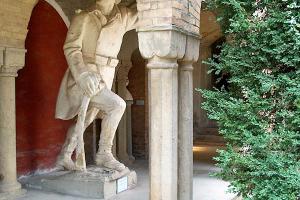The master collected the original casts of his statues in public places and in churches in the country and exhibited them under the arcades just like in a storage. You should not expect any kind of aesthetic order here. Let’s look at it as a real studio of an artist where his different old and new works are placed randomly, without any system on shelves or stands. You should not miss this part of the exhibition. You might surprisingly realise it again and again that you have already seen some of them in the country, in Szeged, Kaposvár, Budapest or somewhere else, and you didn’t know who made them.
The statue called the Birth of the Huszár (Hungarian cavalryman) can be found at the public pool in Székesfehérvár and in front of the obstetrics of János Hospital in Budapest. The huszár does not arrive to the world carried in the beak of the stork, but he rides on its back.
The cast copies of the four figures on the Bishops Fountain in Székesfehérvár can be found under the arcades too. It stands in the park next to the bus station now, but first it was placed in front of the Bishop’s Palace exactly where the Orb can be seen now. Later it was moved to the railway station and then to its present place. Asztrik, who is facing the Cathedral on the fountain, symbolizes the Roman Catholic Church, the supporter of kingdom. Gellért, who is looking towards Buda where he died as a martyr, symbolizes the martyr Catholic Church. He is holding the cross facing himself and is kneeling on one knee on the cliff shrunk from the depth. Mór, who was looking towards the old palace of the kings at the original place of the statue and is making Prince Imre read the Bible, embodies the educational Catholic Church. Adalbert, who christened Vajk and named him István, symbolizes the proselytizer Catholic Church.




